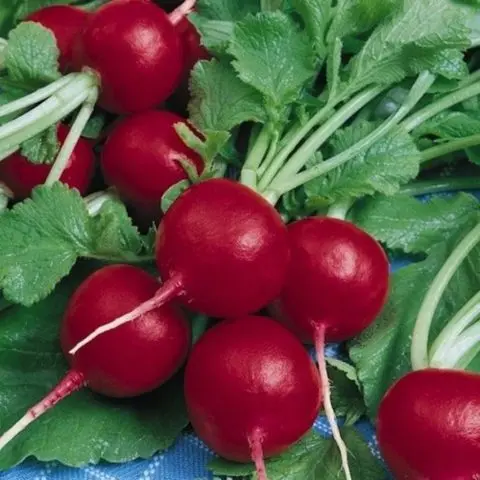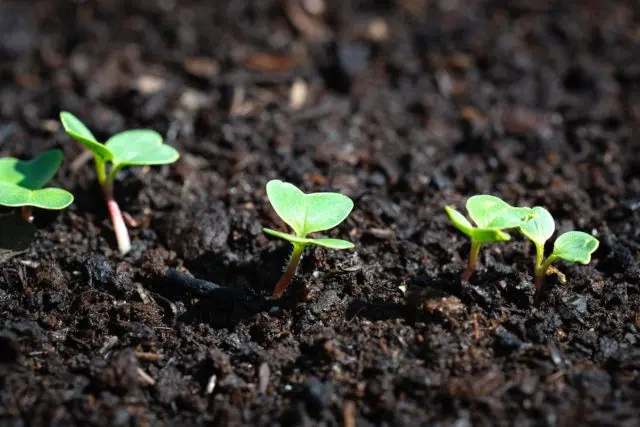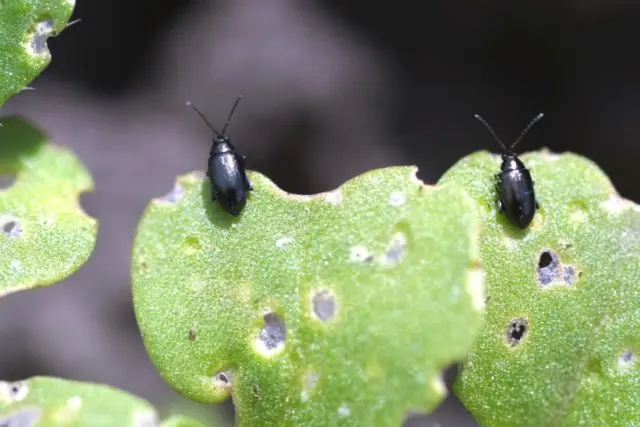Contents
Diego radish is one of the most common varieties of this crop, which was known to Europeans even before the appearance of potatoes. The vegetable differs not only in taste, but also in ease of cultivation.
Description of the radish variety Diego
Diego radish is a hybrid early ripe Dutch variety that can be easily grown not only in greenhouses, but also in open ground. The F1 marking indicates that the variety is a hybrid, and, therefore, more resistant to various diseases. Therefore, an increasing number of gardeners are choosing this species for cultivation on their plots.
Main characteristics
Diego is a radish variety that has very large root crops, the size of which reaches 5 cm in diameter, and the weight varies within 60 g. Root crops, painted in bright red, almost burgundy, are distinguished by their taste:
- juiciness;
- lack of bitter taste;
- white pulp;
- nice crunch.
Productivity
Radish Diego F1, according to reviews, is a high-yielding variety. The germination rate is 99%, and even adverse weather conditions do not have a special effect on the yield. Therefore, the amount of the harvest depends entirely on the scale of planting this vegetable.
No less important is the fact that Diego belongs to early ripening varieties: only 20-30 days pass from the moment of sowing and harvesting.

Advantages and disadvantages
Understanding gardeners know that each plant has its own advantages and disadvantages. The disadvantages of the Diego variety include only the fact that vegetable seeds are a little more expensive than varietal seeds. Otherwise, Diego has only positive qualities:
- resistance to cold;
- unpretentiousness in cultivation;
- short ripening period;
- high yield;
- the possibility of long-term storage;
- the content of numerous vitamins;
- lack of emptiness in the root crop;
- resistance to pests and pathologies;
- the ability to adapt to climatic conditions.
Rules of landing and care
In order to harvest a good crop of radish, it must be planted correctly. Diego’s planting algorithm is no fundamentally different from planting any other radish varieties, so any novice summer resident can handle this process.
Recommended dates
Diego radishes can be planted throughout the summer. The first sowing, as a rule, is carried out already in April (it can be planted earlier, but under a film cover).
The second sowing is carried out in June, and then – as needed and depending on climatic conditions. In regions with dry and hot summers, it is not recommended to plant radishes in the last months of the season if it is not possible to cover the plantings from the sun.
Choosing a place and preparing beds
For any variety of radish, including Diego, the site for planting must meet the following criteria:
- illumination – radishes will not grow in constant shade;
- lack of stagnant water;
- fertile soil rich in phosphorus.
The beds for the Diego radish variety need to be prepared in advance. Radish prefers light soils with neutral acidity. If the site has heavy soil, then it is necessary to add neutral peat, sand and compost even before sowing the seeds. On soils with high acidity, liming is carried out, and the pH level can be lowered by adding ordinary wood ash to the soil.
On prepared and fertilized beds, it is necessary to make several grooves so that an interval of 10-15 cm is maintained between them. If the planting is too thick, the vegetable will grow slowly, and its fruits will become small. For the cultivation of grooves, you can use a narrow board: in this way they will turn out not only even, but also their lower part will be compacted. This is necessary so that the seeds do not go deeper than 1,5 cm.

Landing algorithm
On prepared beds, radishes are sown as rarely as possible, otherwise the young shoots will have to be thinned out. Since Diego radish seeds do not need pre-soaking, you can use a special device – a spot seeder.
Next steps:
- A thin layer of soil is poured over the seeds, which needs to be tamped down a little.
- From above it is recommended to pour a small layer of peat or sand mixed with ash.
- The last step is abundant watering of the radish.
Peculiarities of growing
To get a high yield when planting the Diego variety, you need to responsibly approach its cultivation. You won’t have to make special efforts: the main thing is to follow the basic recommendations that relate to watering and feeding the plant.
Watering
Radish is a moisture-loving crop. Therefore, immediately after sowing, the vegetable must be provided with a sufficient amount of moisture.
In the first two weeks, watering should be carried out regularly, as the earth dries up. It is best to determine this empirically, as the frequency and amount of watering can vary from region to region.
After the roots begin to form, watering can be reduced. At this time, it is important to prevent stagnation of water in the soil so that the vegetables do not crack.
Thinning
Careful thinning of the fruit will also help ensure a high yield. If the plantings are too dense, then the root crops will have little free space for growth and development, which will lead to their deformation and reduction in size. It is best to keep an interval of 7-10 cm between seedlings.
Additional fertilizing
Diego is a radish variety that does not tolerate fresh organic matter. Therefore, the soil must be fertilized with humus even at the stage of preparing the beds.
Mineral complexes act as an ideal fertilizer. It is they who are advised to make at the time of the formation of root crops or in the process of preparing the beds for planting.
Pests and diseases
Diego is a variety of radish that is not afraid of many diseases common to this culture. The only thing that can affect a plant is rot. But it occurs only in cases where there is a constant stagnation of moisture in the soil.

Among the pests that can attack Diego’s radish, reviews note cruciferous fleas, bedbugs, and cabbage pests. But all of them will not harm the plant if the culture is treated with an infusion of garlic, ground pepper or powdered mustard is poured onto the ground.
If, however, radishes still have problems such as underdevelopment of fruits, early bolting or flowering, then the cause should be sought in other adverse factors, for example:
- frosts – relevant for a crop planted before the soil warms up;
- lack of moisture for a long time;
- excess sunlight (more than 10 hours a day) or its lack;
- dense plantings that were not thinned out in a timely manner.
Conclusion
Diego radish is a root crop variety that impresses with its taste, fast and uniform germination, ease of care and balance of nutrients and vitamins. Therefore, the hybrid is gaining more and more popularity every year among avid summer residents and novice gardeners.









